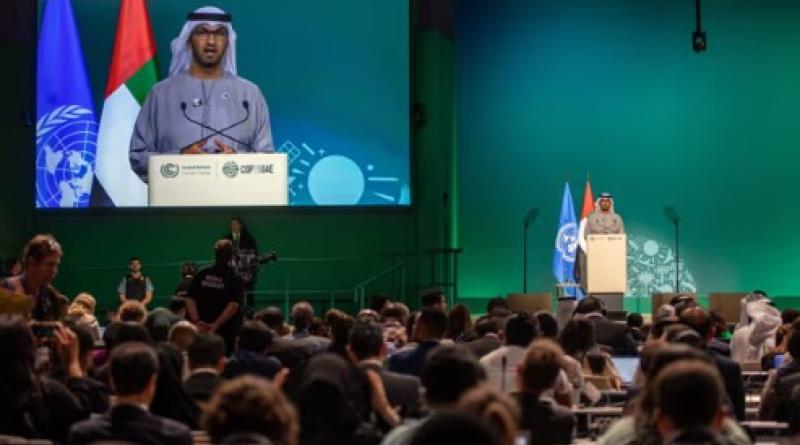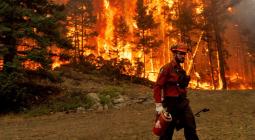Cop28 has finally named fossil fuels as the climate problem. But do leaders have the will to act?

From the start, Cop28 appeared beyond the reach of satire. About 100,000 politicians, diplomats, lobbyists, business people, investors, activists, scientists, policy wonks and journalists from across the globe registered for a two-week climate summit hosted by an authoritarian oil state in a city, Dubai, known for skyscrapers and extravagant, energy-hungry consumerism.
The president of the summit, Sultan Ahmed al-Jaber, is the chief executive of the state-owned Abu Dhabi National Oil Company, which is planning a US$150bn oil and gas expansion. The United Arab Emirates is also investing in renewables – its Noor Energy 1 concentrated solar thermal plant is bigger than 6,000 football fields – but a more prominent sight in central Dubai is the world’s biggest gas-fired power plant.
With this setup, what could possibly go wrong? A few things, as it turned out. A few also went right. Whether you judge the result as more good or bad in part depends on expectations coming in.
The event was held across a site built to host a recent World Expo. It was readymade for a massive trade fair, which is what the annual climate conference has become for most delegates. More than 150 world leaders turned up at the start, some arriving on private jets and staying only a few hours. Anthony Albanese, under pressure at home on multiple fronts, was not among them. Neither were Joe Biden or Xi Jinping. But this was mostly not a leaders’ event.
Beyond the hoopla, Cop had an important focus: negotiations between delegates from nearly 200 countries over how to ramp up the global response to an escalating climate crisis. The outcome – landed, in the time-honoured tradition of climate summits, after a couple of near-sleepless nights and well after the scheduled deadline – is a mixed bag.
The good news was that, for the first time, the summit accepted fossil fuels were the main climate problem. There was a “supermajority” of countries supporting a phase-out of fossil fuels, but no consensus as required under the UN process. Saudi Arabia and its allies in the Opec oil cartel were the most obvious opponents, but other major emitters were happy to hide in the shadows behind them.
Instead, the final text called on countries to contribute to a transition “away from fossil fuels in energy systems in a just, orderly and equitable manner, accelerating action in this critical decade, so as to achieve net zero by 2050 in keeping with the science”. Australia’s climate change minister, Chris Bowen, had a hand in the compromise, having suggested it in a tense plenary session.
The final words will read as a statement of the blindingly obvious to some people, but it seemed impossible just a couple of years ago that a climate summit agreement would name and shame fossil fuels, including oil and gas. It’s a moment of some progress.
It doesn’t mandate anything, but it should help build momentum for more action from governments and major institutional investors looking for a signal about where and when to spend trillions of dollars. The Paris climate agreement’s commitment that countries would pursue efforts to limit global heating to 1.5C above pre-industrial levels did a version of this in 2015. It told investors that the market for green energy would have to grow. This should be another step in that direction.
The bad news is that the agreement doesn’t go far enough to capture the urgency needed to avoid worsening climate destruction, and that it includes language that gives succour to those wanting to delay or avoid action.
This year has been the hottest on record. It brought extreme weather and heat-related disasters that played havoc with lives and livelihoods across most continents. Investment in renewable energy has grown dramatically, but has too often been added on top of fossil fuels, not replaced them. Global greenhouse gas emissions from coal, oil and gas continue to rise. Petrostates are still planning massive fossil fuel expansion. Inger Andersen, the executive director of the UN environment programme, was correct when she accused governments of saying one thing and doing another.
At the centre of debate in Dubai was a global stocktake of progress that found the world was not on track to keep 1.5C within reach. The so-called “UAE consensus” agreement recognises that and references what is necessary to address it. But there is a long way to go if that possibility is to become a reality.
Anne Rasmussen, the Samoan lead negotiator for the 39-member Alliance of Small Island States, summarised the situation in the final plenary on Wednesday: “We have made an incremental advancement over business as usual when what we really needed is an exponential step-change in our actions and support.”
She’s right and the truth is this is how the Cops process operates. Multilateralism is a slog, demanding consensus where it doesn’t exist. A large country pushing a lowest common denominator position usually prevails. From one perspective, this makes the UAE agreement on fossil fuels a more remarkable achievement – no one stood up at the final plenary to weaken it.
They probably thought they didn’t need to because the deal includes enough get-out clauses for polluters to lean on. They include a mention of carbon capture, utilisation and storage – a struggling niche technology being used in Australia and elsewhere to justify fossil fuel expansions that will pump huge amounts of greenhouse gas into the atmosphere – and “transitional fuels”, a phrase promoted by Russia and fossil fuel industries as code for more gas.
This reference was included despite gas being the largest source of global emissions growth last decade.
These damaging sections sit alongside genuinely good stuff, such as a call to triple global renewable energy by 2030 (a UAE suggestion, it should be noted). It gives the agreement a choose-your-own-adventure flavour within a long-term shift to cleaner practice. The problem is we don’t have time for that.
What does all this mean for Australia? Bowen was an active player in Dubai, wrangling the umbrella group of countries that includes the US, UK, Canada and Japan, raising Pacific concerns and winning private praise from some usual critics of the Albanese government’s climate policies. Vanuatu’s climate change minister, Ralph Regenvanu, told the Guardian he was “happy with what Australia has been saying”, describing it as a “real change”.
Bowen was clear about what he believed the summit had decided: “All nations of the world have acknowledged the reality that our future is in clean energy and the age of fossil fuels will end.”
The shift to renewable energy replacing fossil fuels in the national electricity grid is already on an irreversible path and needs to happen quickly just to keep the lights on as old coal plants shut. Gas peaking plants will have a back-up role to play only and, unlike in other countries, there has been no compelling case that nuclear energy can help. Managing this historic shift is the challenge now.
The bigger question is what it means for the country’s massive fossil fuel exports – Australia’s biggest contribution to the climate crisis. Pressure on the government to explain how the country can quickly go from supplying Asia with coal and gas to exporting clean energy will only grow.
It will be politically challenging at home, but Australia will also be expected to do much more on climate finance. For years, wealthy nations have promised to help developing countries take a clean path out of poverty and build resilience to the climate crisis. An agreement in Dubai to operationalise a loss-and-damage fund means the rich have also committed to cover the cost as the most vulnerable recover from emissions-fuelled catastrophic events.
All this will cost trillions. Some will need to come from private sources, but Australia will be expected to go well beyond the $150m it promised in the UAE.
A final point to make is about emissions targets. New commitments for 2035 are due by 2025. The Cop28 agreement spells out what’s needed: a global 60% cut compared with 2019 levels.
For Australia, which uses a 2005 baseline, that equates to a 67% cut – and the country will face calls to go further given developed nations’ historic responsibility to take the lead. Bowen argued publicly for the inclusion of the 2035 goal on behalf of the umbrella group.
The test of this will come over the next 18 months. The country’s three biggest states now each promise at least a 70% emissions cut by 2035. Western Australia, on the other hand, is a problem. The question for the Albanese government will be whether it will make the case for a target and the policies that are needed, and stare down fossil-fuel captured parts of the political and media ecosystem.
Where it lands will say a lot about whether Australia is serious about keeping 1.5C in play, helping its friends in the Pacific and making the most of the economic opportunities we hear so much about.






